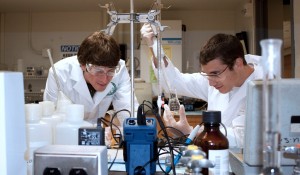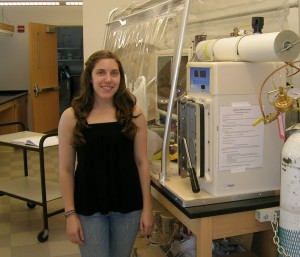
Brian Peacock ’12 and Michael Thompson ’12 work in the lab.
When Michael Thompson ’12 (Shokan, N.Y.) received the call confirming he was selected for the Environmental Protection Agency-Greater Research Opportunity (EPA-GRO) fellowship, he was so excited he dropped the phone.
Melissa Haber ’12 (Piscataway, N.J.) and Brian Peacock ’12 (Haddonfield, N.J.) also received fellowships, which finance research supplies and provide tuition assistance and a stipend during the semester. Each student also will serve a three-month internship with the EPA next summer.
For Thompson, who turned a childhood fascination with Lego blocks into a civil engineering major, the fellowship allows him to continue his current projects while getting a taste of what research will be like after Lafayette.
“Engineering is basically just solving problems, and I enjoy solving problems,” he says. “Working for the EPA instead of the College will be a change into a new environment, which sounds fun.”

Melissa Haber '12 with an anaerobic chamber at University of California-Davis.
Haber’s passion for biology began in high school and was further piqued through a two-week externship at Rockefeller University in New York City during her first year at Lafayette. Like Thompson, she’s looking forward to the challenges of conducting research outside academia.
“[The field of] biology is always changing,” she says. “There are new discoveries every day and I love to be a part of the exploration. Entering the EPA project will force me to conquer the steep end of the learning curve quickly, which is a valuable skill.”
A civil engineering major, Peacock is preparing research on wetlands that will become his senior honors thesis. Fascinated by a technique called ecological engineering, which uses artificial ecosystems to treat and use waste, he plans to pursue a Ph.D. in the field.
All of the students credit the undergraduate opportunities available at Lafayette with helping them develop the research chops needed to secure the EPA-GRO fellowships. Although they are just beginning their junior years, the College already has served as a launching pad for their research careers.
“The research facilities are outstanding and the small size of the school has enabled me to access all of the facilities with unprecedented ease,” says Peacock. “It has been great to work closely with professors and have the freedom to explore my own ideas.”
Thompson agrees that the one-on-one attention from faculty has helped him excel.
“It’s like nothing I ever imagined a small school could offer for a science-based program,” he says. “I believe I have received a better education and experience here than I could have at any technical institute.”
Haber has worked extensively with Laurie Caslake, associate professor and head of biology, on research using microscopic bacteria to strengthen soil. Through Caslake’s collaborative National Science Foundation grant, Haber spent this summer working with Jason DeJong, associate professor of civil and environmental engineering at University of California-Davis, and his graduate students on an interdisciplinary soil treatment project. They are attempting to use a bacterium naturally found in soil that produces calcite to improve a soil remediation technique. Calcite binds soil particles together under the right conditions, a process that potentially could be used to strengthen the soil beneath structures where natural disasters occur frequently.
Peacock studied abroad last semester in New Zealand, where he worked with Dan Hikuroa, community earth systems science programmes manager at the Institute for Earth Science and Engineering in Auckland. Peacock used geographic information systems to develop a riparian buffer placement tool, which employs data to assess hydrological, ecological, pollution, economic, social, and cultural merits to rank sites for restoration and preservation. He also is collaborating with Art Kney, associate professor of civil and environmental engineering, in research on constructed wetlands. Their work was presented at the 2010 ASCE World Environmental & Water Resources Congress and published in the conference proceedings. He previously conducted research with Kney and other students on nitrogen cycling in municipal waste compost.
Working as an EXCEL Scholar with Kney and David Brandes, associate professor of civil and environmental engineering, Thompson developed a graphical screening method that can predict the quality of stream water. A volunteer can test a water sample for hardness and electrical conductivity, and then plot the results on the graph. The location of the plot point determines if the water is clean or impacted. They are preparing a paper to submit to the Journal of Environmental Management.
See a list of recent Lafayette recipients of national and international scholarships and fellowships for undergraduate and post-graduate study. For information on applying for scholarships and fellowships, contact Julia A. Goldberg, associate dean of the College, (610) 330-5521.


2 Comments
Comments are closed.